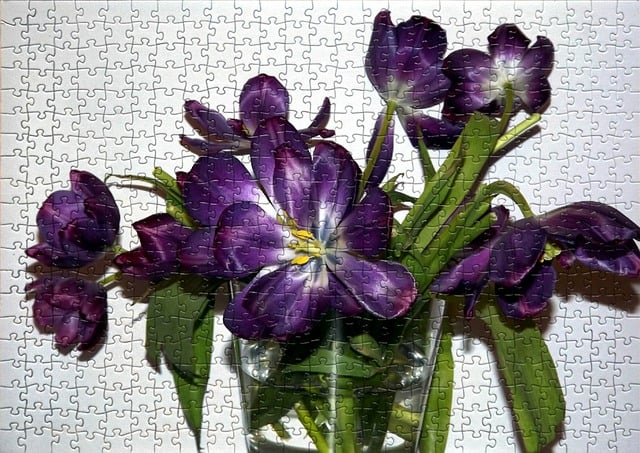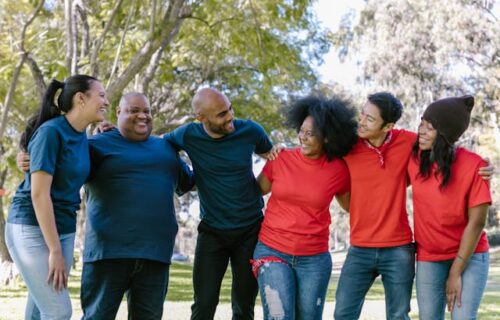
Puzzle it out
When I was growing up, my family often did jigsaw puzzles—usually the same ones over and over: a variety of birds, a variety of flowers, a variety of butterflies. We didn’t have a TV, so puzzles were a common pastime, solved on a folding card table in the living room.
My father was a huge fan of jigsaw puzzles. Okay, maybe he was an addict. His puzzles were not of the card-table flavor.
In his study, he had an enormous sheet of plywood on which he would arrange all his pieces and fit them together. He carefully tracked how long a puzzle took him and noted it on the inside of the top cover.
His family, friends, and colleagues knew of this pastime and fed his addiction mercilessly through their gift-giving: here’s a puzzle that’s a repetitive black and white pattern; here’s one called “Red Riding Hood’s Hood”—just shades of red; here’s one with the same picture on both sides—only rotated 90º; here’s one gifted in a bag with no picture to go by….
After he died, we donated most of them, perhaps to the nursing home? the library? The birds, flowers, and butterflies we kept.
My own kids had their share of jigsaw puzzles—and it wasn’t really a favorite pastime. And I was much too busy to do them for decades. We’d occasionally do them at Grandma’s house over Christmas.
the puzzle + the pandemic
When socializing outside the home was drastically reduced by the pandemic, I rediscovered puzzles—and while I haven’t gone so far as to track my hours, I find myself seeking out puzzles that will challenge me for a few weeks.
My favorite puzzle company, Pomegranate, has a series that uses famous works of art as the subjects. I’m currently on my sixth one—Rebecca Campbell’s “Do Not Disturb”—and I may have met my match!
Let’s just say it’s a good thing that I don’t need to use my dining room table any time soon: this one is going to take a good long while.
We have been isolating quite seriously—most weeks, the only place we go is to the grocery store and occasionally to get takeout. When our favorite independent bookstore reopened for in-person shopping, we did go in, and I was shocked to see how many puzzles they now carry.
“Oh yes,” the sales clerk told me, “this is definitely a thing now.”
They aren’t an outlier: NPR reports that puzzle sales have skyrocketed during the pandemic.
the benefits of a jigsaw puzzle
It turns out that doing jigsaw puzzles has a lot of benefits, especially for our brains. In addition to being a popular pastime, they can help children in their skills development and prevent major illnesses in the elderly.
Studies note that solving jigsaw puzzles can increase our brain reserves and regulate distressing emotions, meaning that we can:
- Improve visual-spatial reasoning
- Increase attention to detail
- Improve memory
- Increase IQ
- Improve problem-solving capacity
- Increase productivity
- Build collaboration + teamwork and improve relationships
- Improve mood
- Lower stress
That’s an impressive list.
(As I’m somewhat of a Luddite, the snarky side of me wants to know, can screen time can claim any of those benefits?)
doing it my way
I was tickled by the “build collaboration and improve relationships” item on the list: I can be very competitive and extremely invested in my way of doing things.
It’s definitely a challenge for me to share a puzzle with someone who 1) finds that piece that’s been bugging me for days and/or 2) doesn’t put rejected pieces back where they belong in “the correct” rotation.
That’s right, I do have a particular system for doing a puzzle (I know, you’re shocked):
- Like most people, I start with the edges. My favorite story about this practice comes from the eulogy delivered by the daughter of my daughter’s godfather: apparently, it was a shock for her to learn at a friend’s house that it was NOT an actual law that the edge had to be completed first!
- Then I sort by colors/patterns that are obviously identifiable and finish the more easily done parts of the picture.
- Once the “easy” parts are done and what remains is filler/background that is mostly similar in colors/patterns, I actually sort pieces by shape and lay them out in (very) neat rows in which each shape is aligned the same way. (This is the point at which I snap if someone puts back a rejected piece in the “wrong” section or turned the “wrong” way.)
I think “Do Not Disturb” is challenging me so because there are minimal “easy parts”—I’m having to spread out about 900 pieces and jump from step 1 to step 3.
I may have to change up my alignment and sort by piece shape and then line up the books (rather than the shapes) to face the same way?
It’s fortunate that I’m really the only person in the house who spends much time on puzzles. Or perhaps I’m the only person who does so because I obviously still need to work on the building collaboration and improving relationships part of this project?
Let’s call that my growth edge. Pun intended.
health coach puzzle
As a health coach, I often help my clients develop an awareness of their actions and behaviors—not in a judgy way but in a curious way.
I always say that there are two ways to ask the same question about a goal you didn’t achieve or an activity that didn’t go as planned:
- O.M.G. WHY CAN’T I DO THIS? (100% judgment—this is a conversation stopper. Nothing will be learned.)
- Huh. Why can’t I do this? (100% curiosity—this is the beginning of a conversation through which much can be learned.)
If you ask yourself the question with curiosity, you can then move on to exploring what got in your way and how you can set yourself up for success next time.
Just as with solving a jigsaw puzzle, you can try using different approaches to the same problem, form a theory, test your hypothesis, change perspective and direction as necessary.
As with a jigsaw puzzle, our health goals are often not a surprise: you know what the picture looks like that you’re working toward (well, unless your colleagues don’t give you the box for the puzzle!)
So the important part of the puzzle/goal becomes the journey, the process of getting there.
And that’s where the gold really lies: staying in the present and making the journey/solving the puzzle day by day—just like I tell my clients about reaching their health goals! It’s not about grand gestures and radical changes; rather, it’s about putting one piece in place at a time.
make the connection
Research shows that when the outcome is already known, it’s the process of getting there that gives us that hit of dopamine we crave: our brains actually think we’re hunting, and we use both the logical reasoning/reckoning, detail-oriented side and the imaginative, big-picture side.
As I’ve worked through four 1000-piece puzzles and one 2000-piece puzzle, I swear I can feel the less-developed creative/imaginative side of my brain developing.
I’ve noticed that in my work life, I’m spending more time thinking about the big picture of my coaching practice: seeing how the details all fit together rather than getting mired down in those details.
What are you doing in your life—particularly during the pandemic—that is more about the process than the outcome and has the potential to affect you positively in the long term?



